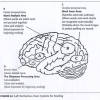Neural Systems for Reading
Nov 26th, 2010 | By dkrupke
As more educators come to understand learning and the brain, teaching practices and strategies improve, benefiting all learners. The following is a brief summary of information from the work of Dr. Sally Shaywitz and Dr. J. Richard Gentry relative to brain systems for reading. Broca’s area (area A in Gentry’s diagram of the brain) is the Phoneme Processing Area. This is where subvocalization occurs . . a process that is slow and analytical and most likely to be used in the beginning stages of learning to read, according to Shaywitz and Gentry. This area might be activated when a K teacher has children shouting out the rhyming word in a nursery rhyme as they repeat a part in unison. Broca’s area is also the “speech” area, dealing with articulation . . . how sounds are formed in the mouth. The second area of importance is the Word Analysis Area in the parieto-temporal area of the brain (area B). This is where words are pulled apart and put back together, in essence, linking sounds to letters. It is my belief that the use of Visual Phonics hand shapes helps to activate this area. This is also slow and analytical . . […]